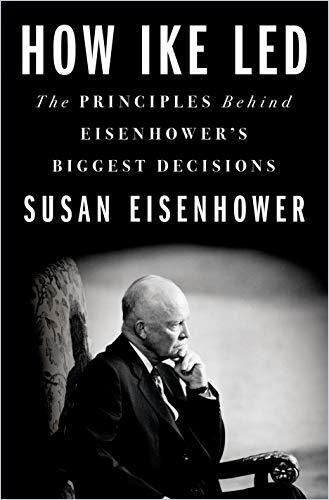Dwight D. Eisenhower’s granddaughter Susan Eisenhower offers a politically and emotionally astute accounting of Ike’s life and career.

Dwight D. Eisenhower, by His Granddaughter
Ike’s Granddaughter
One of President Dwight D. “Ike” Eisenhower’s four grandchildren, Washington, DC policy strategist Susan Eisenhower, worked extensively on national security issues. Naturally, she’s not here to list all her grandfather’s faults, but her work stops short of hagiography.
Ike – who led the Normandy invasion as Allied commander and led the United States as a two-term president – was a complex man with an almost impenetrable surface. Ms. Eisenhower tunnels beneath that surface to reveal Ike’s complexity and the complexity of his time. Her personal memories add to her portrayal of this pivotal figure.
One of her overarching themes is that Eisenhower was a realistic strategist focused on achieving a higher purpose and the best possible future. Coping with health problems, Eisenhower remained – in this portrait – a responsible, humble leader with a powerful sense of duty.
Responsibility for Consequences
To best illustrate his sense of responsibility, Ms. Eisenhower tells how, on the eve of the D-Day invasion, Ike wrote a note to every group involved in the attack – to be read only if the mission failed. The note said that the decision to attack was made with all available information, that the troops were the best and most courageous, and that any failure was Ike’s fault alone. The author honors Ike for taking a public route to underscore his accountability.
Private Pain
Ms. Eisenhower identifies Ike’s strength as resulting from his will, self-control and compassion. He saw displays of emotion or emotional reliance on others as vulnerability and weakness.
Eisenhower’s greatest value as a leader was that he overcame his struggles and also heart-numbing pain – in private.Susan Eisenhower
Ms. Eisenhower movingly portrays Ike as struggling to control his conflicted emotional life. She regards his ability to master his passions as pivotal to his leadership accomplishments as a general and as president.
Personal gestures
Ms. Eisenhower offers an interesting, if not particularly enlightening, historical parallel. She posits that former president and Civil War general Ulysses S. Grant and Ike both attended the US Military Academy at West Point because it was free; neither graduated near the top of his class and, the author insists, neither had any early interest in a military career.
Duty, in Ike’s higher form, was intangible; it was woven into his DNA and revolved around selflessness and self-sacrifice.Susan Eisenhower
The author holds that Ike took his sense of vocation and duty from West Point. She believes this aligned with his lack of egoism and embrace of self-sacrifice.
Postwar
In November 1945, Ike became the US Army’s chief of staff. Ms. Eisenhower marvels at Ike’s humane, aware guidance. In September 1945, she offers as an example that Ike insisted US troops give Holocaust survivors special attention, that a Jewish consultant move among the camps to help them and that the Army should keep Ike apprised of the situation.
Urged to Run
Even before the end of the Second World War, Ms. Eisenhower makes the case that political operatives had already urged Ike to run for president. She views Ike as ambivalent about politics. By 1948, when he was the president of Columbia University, Ms. Eisenhower discloses that even Democratic Party leaders called for him to run. The author offers up the blockbuster that President Truman privately conveyed to Ike that he wouldn’t seek re-election if Eisenhower chose to run. Even when Ike ran for president four years later in 1952, Ms. Eisenhower avows that his political views and party affiliation remained unclear.
“Progressive Republican”
Ms. Eisenhower describes Ike, who became the 34th president of the United States on January 20, 1953, as coming from deep, progressive Republican roots.
Eisenhower’s views…did not fit neatly into the orthodoxy of either party, and he understood the challenges inherent in what he would dub ‘the Middle Way’.Susan Eisenhower
As proof of this contention, the author refers to the fact that during his first term in office, Ike expanded Social Security by millions of dollars and brought in a balanced budget. Further, the author reveals, he believed appointees to the Supreme Court should come equally from Democrats and Republicans. He appointed William Brennan Jr., a Democrat and historically progressive justice.
Joseph McCarthy
Ms. Eisenhower is perhaps too generous when discussing Ike’s refusal to confront the rabble-rousing, Commie-hunting senator Sen. Joseph McCarthy. The author chooses to portray her grandfather as patient rather than pusillanimous.
The Soviet Union
Ms. Eisenhower details the Soviet Union’s violent suppression of Hungary’s democratic uprising, in which thousands of people died. The author makes it plain that it was impossible for the US military to intervene; Soviet-aligned and neutral countries surrounded Hungary. Stymied, Ike granted priority to Hungarian refugees seeking to emigrate to the United States.
Civil rights
Ms. Eisenhower proudly relates that Ike proposed civil rights legislation in 1957 and established a Civil Rights Division in the US Justice Department. In September 1957, he sent the 101st Airborne, which had served in the Normandy invasion, to Little Rock, Arkansas, to ensure integration of the schools.
Romeo and Juliet
Lest you suspect Ms. Eisenhower of a lack of complexity or of writing only about her famous grandparents (another of her books, Mrs. Ike, traces the life and career of her grandmother, Ike’s wife Mamie Eisenhower) she wrote a much earlier work, Breaking Free: A Chronicle of Love and Revolution, which recounts her clandestine, Cold War-era, Romeo and Juliet-like affair with Russian physicist Roald Sagdeev, whom she later married.





